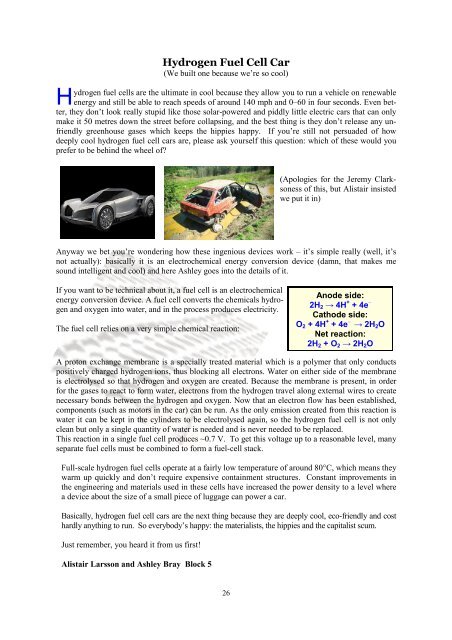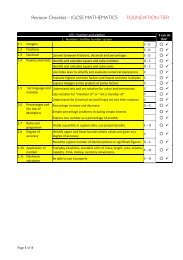Create successful ePaper yourself
Turn your PDF publications into a flip-book with our unique Google optimized e-Paper software.
Hydrogen Fuel Cell Car(We built one because we’re so cool)ydrogen fuel cells are the ultimate in cool because they allow you to run a vehicle on renewableH energy and still be able to reach speeds of around 140 mph and 0–60 in four seconds. Even better,they don’t look really stupid like those solar-powered and piddly little electric cars that can onlymake it 50 metres down the street before collapsing, and the best thing is they don’t release any unfriendlygreenhouse gases which keeps the hippies happy. If you’re still not persuaded of howdeeply cool hydrogen fuel cell cars are, please ask yourself this question: which of these would youprefer to be behind the wheel of?(Apologies for the Jeremy Clarksonessof this, but Alistair insistedwe put it in)Anyway we bet you’re wondering how these ingenious devices work – it’s simple really (well, it’snot actually): basically it is an electrochemical energy conversion device (damn, that makes mesound intelligent and cool) and here Ashley goes into the details of it.If you want to be technical about it, a fuel cell is an electrochemicalenergy conversion device. A fuel cell converts the chemicals hydrogenand oxygen into water, and in the process produces electricity.The fuel cell relies on a very simple chemical reaction:Anode side:2H 2 → 4H + + 4e –Cathode side:O 2 + 4H + + 4e – → 2H 2 ONet reaction:2H 2 + O 2 → 2H 2 OA proton exchange membrane is a specially treated material which is a polymer that only conductspositively charged hydrogen ions, thus blocking all electrons. Water on either side of the membraneis electrolysed so that hydrogen and oxygen are created. Because the membrane is present, in orderfor the gases to react to form water, electrons from the hydrogen travel along external wires to createnecessary bonds between the hydrogen and oxygen. Now that an electron flow has been established,components (such as motors in the car) can be run. As the only emission created from this reaction iswater it can be kept in the cylinders to be electrolysed again, so the hydrogen fuel cell is not onlyclean but only a single quantity of water is needed and is never needed to be replaced.This reaction in a single fuel cell produces ~0.7 V. To get this voltage up to a reasonable level, manyseparate fuel cells must be combined to form a fuel-cell stack.Full-scale hydrogen fuel cells operate at a fairly low temperature of around 80°C, which means theywarm up quickly and don’t require expensive containment structures. Constant improvements inthe engineering and materials used in these cells have increased the power density to a level wherea device about the size of a small piece of luggage can power a car.Basically, hydrogen fuel cell cars are the next thing because they are deeply cool, eco-friendly and costhardly anything to run. So everybody’s happy: the materialists, the hippies and the capitalist scum.Just remember, you heard it from us first!Alistair Larsson and Ashley Bray Block 526
















